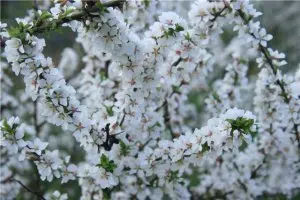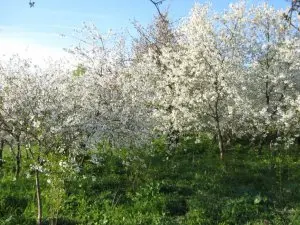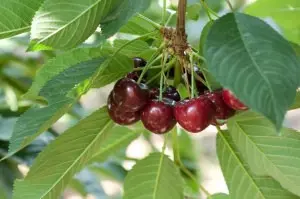Contents
In the spring, cherry blossoms can bloom very profusely. Gardeners, looking at the branches strewn with white flowers, look forward to harvesting the same plentiful harvest. However, their hopes are not always justified, and instead of juicy berries, only empty stalks remain on the branches. There are several possible reasons why cherries are not fruiting in your garden.
Possible reasons
Insufficient pollination
Cherry is a cross-pollinated plant, that is, an ovary occurs when pollen from a different variety falls on the pistil. All varieties are divided into self-fertile, partially self-fertile and self-fertile or ordinary.
One of the most common reasons why cherries do not bear fruit is the lack of a proper pollinator. Not all varieties of cherries are capable of self-fertility, that is, they are independently pollinated by their own pollen. Such trees require a pollinator, a different variety of cherry, whose pollen is suitable for mutual cross-pollination, in order to set fruit. Pollinators bloom, as a rule, simultaneously with a variety that is not capable of independent ovaries. Such trees should be planted no further than 20-30 meters relative to each other. Therefore, the selection of the necessary and desired variety, determining the landing site is an important task.
Ordinary varieties of cherries without pollinators will set only 5-7% of the possible harvest, and self-fertile ones – up to 40%. It is advisable to use when planting the root shoots of only those trees that you are sure of fruiting, and not limit the garden to one variety of cherries. In cases where it is not possible to plant an additional pollinator variety, they should be grafted into the crown of the corresponding tree or bush. As a last resort, in the spring, during flowering, you can put flowering cut branches of a different variety next to the tree.

Fungal diseases
If the cherry does not bear fruit, it is possible that the tree is infected with such a harmful disease, coccomycosis. As a rule, this fungus infects leaves, rarely fruits in late varieties. In early summer, after flowering, brown spots or a pinkish-red bloom appear on the leaves. The leaves wither and fall off, the tree weakens and becomes sensitive to severe frosts. In spring, the infected tree ceases to bloom profusely, and fruit buds are not laid.
A disease such as monilial burn is also common. It appears in the spring. The causative agent penetrates the fruit shoots and buds along the pedicel, causing them to wilt. Often, dried leaves and flowers remain on the tree until next year. And in the summer, even green fruits begin to rot, not having time to ripen. It is necessary to remove the affected branches, leaves and fruits in a timely manner, where the fungus overwinters, in order to prevent the further spread of the disease.
Weather
The fruiting of cherries is directly affected by weather conditions. Excessive dampness, hot and dry weather, severe frosts in winter and spring frosts can significantly reduce the fruiting of even a strong and healthy tree.
Poor conditions during the cherry blossom period negatively affect its pollination. In rainy weather or, for example, during a cold snap, the activity of insects that collect nectar and pollen decreases. And in very dry, hot weather, the quality of pollen is significantly reduced, which leads to its timely shedding.
During the period of winter frosts or during short-term spring thaws, flower buds can freeze. The risk of freezing increases especially if the cherries at the end of summer and the beginning of autumn were watered abundantly or fed with nitrogenous fertilizers. Damaged flower buds open later in the spring, the fruits either do not set at all or fall off while still quite green.

Lack of proper nutrition
If the cherry does not bear fruit, the soil may be too acidic, and this tree is extremely sensitive to soil composition and location. Closely spaced groundwater can also cause cherries to bloom but not bear fruit. If the groundwater is closer than 1,7-2 meters, the trees are planted on an artificial bulk hill 2-3 m in diameter and high, providing the required depth of groundwater.
Cherry will give the greatest yield if it grows in sandy soil with neutral, or close to it, acidity. Other acidity should be corrected by liming the soil. However, it should be borne in mind that the lack of boron, often associated with calcareous soil, also reduces the percentage of ovaries. In order for the cherry to bear fruit, the soil should be fertilized regularly and in a timely manner while loosening the soil under the bushes and digging the near-trunk zone.
General condition of the tree
The excessive thickening of the crown adversely affects the yield. Regular thinning and pruning stimulate the growth of new shoots, reduce the risk of disease and weaken the tree as a whole, and allow you to choose the optimal light and shade regime. Damaged, dry, inward-pointing crowns and intertwining branches should be removed.

Blooms but does not bear fruit
Proper care
In order for the cherry to bear fruit, the garden should be planted from a variety of varieties with approximately the same flowering period. Even in self-fertile varieties, planting next to other cherries increases fruiting. For planting material, do not use root shoots. In the event that a tree has been grafted, wilds will grow from its root, and not varietal plants. To propagate the desired variety of cherries grafted on wild, use a cutting from the root.
If the cherry does not bear fruit, fertilize periodically. This should be done better according to the following scheme: in the autumn, under each tree, when digging the near-trunk zone, an average of 60-80 grams of potash and 180-220 grams of phosphorus fertilizers are applied. And they spend two or three additional feedings during the growing season of the baby. The first one begins immediately after the end of flowering, the second – 10-15 days after the first. Top dressing is applied by dissolving 10-15 grams of urea, potassium chloride and 12-16 grams of superphosphate in 22-28 liters of water. Positive results are obtained by the introduction of ash infusion and rotted manure in the fall, but not more often than once every 2-3 years.
Although cherries are very drought tolerant, it is advisable to irrigate 3-4 heavy waters per night, at the rate of 4-6 buckets per tree. The first watering, as a rule, is combined with summer bait immediately after flowering. The second watering is necessary at the beginning of the ripening of the berries, and the third – in the late autumn period, after dropping the foliage, but before the onset of cold temperatures.
Prevention of fungal diseases
Remove last year’s leaves regularly and carefully, as they are the primary source of fungal diseases. Thin out the crown, removing excess, damaged, dying branches. By brown spots on the leaves, you can determine which fungal disease the tree is affected by. You can get rid of diseases with the help of chemical treatment.
The first spraying is carried out at the end of flowering, then after 10-16 days and after harvesting. One or two sprayings should be carried out for prevention purposes. In cases where the time for the first treatment is missed, it is possible to spray the trees before the fruits ripen, with the expectation that there are still 20-25 days left before harvesting.
Video “Why cherry does not bear fruit”
On the video, Doctor of Agricultural Sciences Kanshina M.V. talks about the possible reasons for the deterioration of cherry fruiting in the Leningrad region and Siberia.









